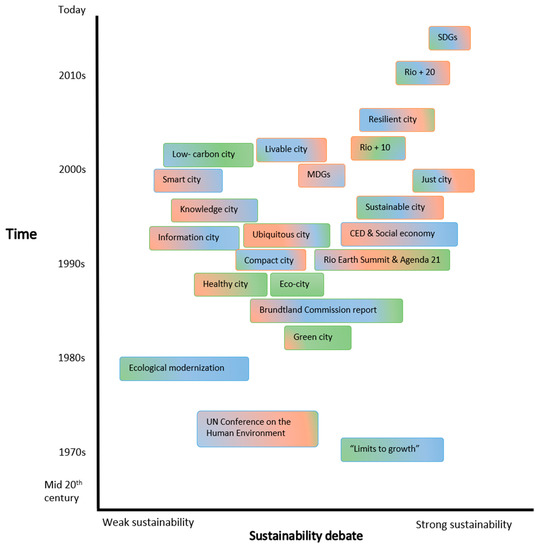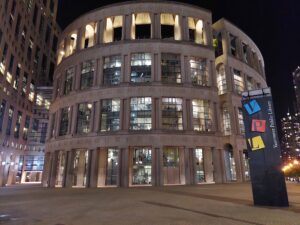by Maria Spiliotopoulou and Mark Roseland.
Journal: MDPI Sustainability. Published September 4th, 2020
Abstract
Achieving sustainability goals is complex and requires policy coherence; yet effective action for structural change has been elusive partly because global issues must be primarily addressed locally. Agreements such as the UN Global Goals and the New Urban Agenda and current pressing problems such as the 2020 pandemic demonstrate that it is impossible to tackle global socio-ecological system issues without addressing urban vulnerabilities and consumption models. This article presents a critical review of theoretical roots, conceptual influences, major debates, limitations, and current trends in community and urban sustainability. Broader sustainability theories and intellectual traditions of the last two centuries have shaped current urban agendas, most of which however do not cater to a systemic approach and may lead to policies that do not integrate all three pillars of sustainability. While cities are challenged by the difficulties of addressing multiple objectives, meaningfully engaging citizens, and consistently tracking progress, the limitations of urban sustainability application can lead to lost opportunities, lack of credibility, and increased public skepticism. Fundamental changes are required in local decision-making and citizen mobilization to move from current piecemeal approaches towards long-lasting urban sustainability and successful implementation of global goals. Keywords: sustainable development; sustainable community development; urban sustainability; sustainable cities; urban agendas; urban development; sustainability planning; sustainability implementation
1. Introduction
A growing number of scholars refer to the modern period as “the Anthropocene”, the geological era marked by the detrimental impact of human activity on the planet. Since the 1972 Club of Rome report on the necessity for limits to economic growth, evidence of the Earth’s deteriorating condition has been mounting. The increased frequency of extreme phenomena, the persistent poverty and inequality, the decline of ecosystem services, and the unprecedented species extinction are only some of the signs that the Earth may soon not be able to sustain current economic and population growth while maintaining systemic planetary well-being [1,2].
Sustainable development (SD) emerged as a field of study after the Brundtland Commission described the connection between human activities and increasing environmental degradation and defined the term as “development that meets the needs of the present without compromising the ability of future generations to meet their own needs” [3]. Despite the SD concept having received copious criticism, it is generally understood as the integration of environmental, economic, and social considerations in the development of a dynamic system [4,5]. In short, it is about “doing development differently” [6].
The message of the 21st century international fora (2002 World Summit on Sustainable Development, 2012 Earth Summit, 2015 Sustainable Development Goals (SDGs), 2015 Paris Climate Accord, and 2017 New Urban Agenda) has been loud and clear: The world must get on the path to a more sustainable future now. We no longer live in a world empty of us and our waste, but rather in a full one that presents significant implications for current and future generations [7]. We therefore need to address current global challenges on multiple scales and in a systemic way to maintain or improve quality of life while decreasing consumption of non-renewable materials and resources.
Achieving national and international sustainability goals is a complex undertaking that requires coordinated and multi-level collaboration. Yet effective action for meaningful, structural change has been elusive despite its urgency, partly because global issues must be primarily addressed at the local level [8]. The success of long-term sustainability goals, such as the SDGs, is conditional on creating and implementing successful, monitorable, and transferable sustainability policies and practices in communities [9,10].
This review focuses on sustainability at the community level, particularly urban areas, and seeks to advance the understanding and practice of sustainable community development (SCD) and sustainable urban development. A community can be defined as “a group of people bound by geography and with a shared destiny, such as a municipality or a town” [6]. A city or urban area is “a human settlement characterized—ecologically, economically, politically and culturally—by a significant infrastructural base; a high density of population, whether it be as denizens, working people, or transitory visitors; and what is perceived to be a large proportion of constructed surface area relative to the rest of the region” [11].
SCD is a holistic approach that integrates social, environmental, and economic considerations into the dynamic processes of complex systems, toward the achievement of community sustainability for the benefit of current and future generations [4,6,8]. SCD has been influenced by several theoretical traditions and movements: In the past it emphasized the reduction of the environmental impact of economic growth, but today considerations of equity and justice are increasingly included in community analysis [8,12]. Sustainable urban development similarly calls for steering away from trade-off mentalities and towards concerted action and collaborative approaches among urban stakeholders [13].
While the early 20th century saw only 13% of the total global population living in cities, today’s estimates bring this number up to 55% [14] or even 70–80% [15]. Urban areas occupy 3–4% of the world’s land surface, use 80% of global resources, consume more than 67% of global energy and other materials, and generate most of the global waste [16,17,18]. Cities are projected to be home to more than two thirds of the world’s population by mid-century, while being vulnerable to climate and health challenges resulting in high economic and environmental costs [10,14,19].
The significance of urban sustainability has been expressed since the 1976 UN Conference on Human Settlements (Habitat I) when governments started perceiving the magnitude and ramifications of rapid urbanization. Following the Rio Earth Summit in 1992, “ICLEI–Local Governments for Sustainability” (formerly known as “ICLEI-the International Council for Local Environmental Initiatives”) catalyzed the adoption of Local Agenda 21 to promote local sustainability planning [20]. In 2012, the Rio + 20 conference also encouraged local sustainability assessment [6].
International agreements such as the New Urban Agenda acknowledge that it is impossible to tackle global socio-ecological system issues without addressing the related processes at the local level [21]. Urban areas are the laboratories for successful sustainable development and our best chance to deal with the environmental impact of human activity [22]. As the mayor of Barcelona, Spain, eloquently explains, “municipalism” and bottom-up policies are required in order to develop “fair, inclusive and diverse” societies [23].
The UN Global Agenda for 2030 has recently brought the urgency for urban sustainability to the foreground by including a goal for “inclusive, safe, resilient, and sustainable” cities (SDG 11). However, the full SDG set is relevant to urban areas and therefore implementation needs to be informed by SCD principles such as long-term and whole-systems perspective and the potential for synergies and indirect positive impact among the various dimensions and goals for sustainability [12,21,24,25,26].
2. Research Methods
The field of urban sustainability has evolved extensively in the last few decades, however conceptual debates remain vivid in the literature while in practice cities face many and complex issues. The purpose of this review is to seek for theoretical roots and conceptual influences, while identifying major debates, limitations, and current trends in SCD and urban sustainability. After studying prominent articles and their reference lists, we followed the snowballing method to identify additional resources. In some cases, we also deemed it useful to consult non-academic sources such as scientific reports, international organization documents, handbooks, or edited books. We evaluated the resources for credibility and soundness, in terms of author, methodology, content, and publication venue.
In this paper, we present our quest to expand our understanding of the concept of urban sustainability, starting with a historical overview tracing the intellectual progression of the field and establishing the context of current issues. The conceptual analysis is then organized by theme or concept, synthesizing the major debates and perspectives to demonstrate the interdisciplinary nature and influences by various fields. The last section explores ways in which community and urban sustainability is operationalized and offers a critical overview of the concept’s application.
3. Urban Sustainability Conceptually
3.1. Historical Progression
The origin of sustainability as a body of knowledge can be traced to environmental and social justice discourses of the 18th and 19th centuries—if not to ancient civilizations [27]. The current concept of sustainable development is thought to have emerged following conferences and influential publications of the 1970s–1980s, such as Rachel Carson’s Silent Spring, the Club of Rome report on limits to economic growth, and the 1972 UN Conference on Human Environment.
For some scholars SD is a decision-making framework [27] and for others it is a societal thinking paradigm and a large-scale discourse on the relationship between social and natural systems [13]. It could also be described as “the emergent property of a conversation about what kind of world we collectively want to live in now and in the future” [28].
Despite an early focus on concerns over environmental and economic issues, the SD discourse has in the last three decades been including social concerns too [6,28,29,30,31]. SD gradually took its current shape after the 1987 Brundtland Commission report, the 2000 UN Millennium Development Goals, and the 2002 Johannesburg Summit, but became more widespread since the universal agreement on the UN Sustainable Development Goals in 2015.
In its seminal report Our Common Future, the World Commission on Environment and Development (Brundtland Commission) revealed that: The poorest fifth of the world’s population had less than 2% of the global economic product while the richest fifth had 75%; and that 26% of the global population consumed 80–86% of non-renewable resources and 34–53% of food products [3]. SD was defined as “development which meets the needs of current generations without compromising the ability of future generations to meet their own needs” [3].
The report has been criticized in many ways, for instance for emphasizing inter-generational (rather than both inter- and intra-generational) equity, and for underestimating the contribution of economic growth and human activity to the expansion of poverty and environmental degradation [29,32,33,34]. The Commission’s SD definition received considerable criticism particularly for being too broad, although recent papers postulate that the vagueness was an intentional political maneuver for the concept to gain wide acceptance [31,33].
For many scholars, this definition subscribes to a worldview that assimilates development to growth while attempting to link economic growth and environmental protection through an anthropocentric perspective within the dominant, colonial-era paradigm of growth [31,33,35]. Nevertheless, this definition is now regarded as classic and at minimum as a starting point for any sustainability discussion.
In the spirit of environmental and political awareness that flourished after the 1992 Rio Earth Summit and the Agenda 21, the UN Member States adopted the Millennium Development Goals (MDGs) in 2000, aspiring to eradicate extreme poverty and reduce inequalities by 2015. The eight MDGs included 21 targets and 60 indicators and had a particular focus on developing countries. Many goals were achieved: Decreases in extreme poverty, child and maternal mortality, and disease rates, and rising rates of primary school enrollment and life expectancy [36,37,38]. Severe issues however persisted in urban areas in sub-Saharan Africa and South Asia, and the MDGs were criticized as being disconnected from a whole-systems view, difficult to measure (in part due to data insufficiency), and potentially causing further inequality in urban areas [36,37].
The post-2015 UN Development Agenda was initiated at the Rio + 20 Earth Summit in 2012 and built partly on the achievements of the MDGs while acknowledging the continuing socio-ecological and economic struggles around the world. In 2015 the UN Member States unanimously approved the 2030 Agenda for Sustainable Development which, with its 17 goals and 169 targets, was a significant step forward and a turning point [39]. The SDGs offer an integrated vision and plan, apply to both developed and developing nations, and are grounded in a holistic view of sustainability [40,41]. The Paris Climate Agreement and the UN New Urban Agenda equally reflect the need to address this century’s principal global challenges holistically and at multiple systemic scales [42,43].
3.2. How Is Sustainable Development Understood?
Sustainable development is usually conceptualized as a three-legged stool, a three-pillar edifice, or a Venn diagram (Figure 1) [20,29,44]. The three-dimensional framework has been influenced by the work of two eminent scholars: Barbier’s 1987 description of the sustainable economic development process as the interaction among economic, biological, and social systems, and Elkington’s Triple Bottom Line concept proposed in the mid-1990s as a management and accounting method [44,45].

Figure 1. The most common conceptualizations of sustainable development. Re-created by the authors, based on these sources: [20,29,30,44].
The terms sustainable development and sustainability have been criticized as ambiguous and open to contradictory interpretations [13,29,46]. The main arenas of debate in the literature discuss whether the two terms, SD and sustainability, are synonyms, and whether SD is an oxymoron if it implies the pursuit of economic growth [27,28,44,45,47].
On the first debate, while the current tendency is to use the two terms interchangeably, our literature review shows that governments and private sector generally prefer SD but academia and non-governmental circles prefer sustainability [34,46,47,48]. In fact, sustainability may be a more inclusive and universal term, whereas SD historically incorporates industrialized world connotations [28].
On the second debate, literature discusses whether SD has in practice concealed an oxymoron, i.e., the objective of unlimited economic growth [27,28]. Until the 1990s, SD was understood as economic development coupled with human rights, peace, and security, and did not necessarily include attention to nature, resulting in environmental degradation and further poverty and inequity [27]. Development, though, should not be confused with growth but challenge and replace it [6]. UNESCO, the United Nations Educational, Scientific and Cultural Organization, for example, recommends redefining development to include cultural, spiritual, emotional, and intellectual well-being [35].
On the lack of definitional consensus, some argue that a simple and generic SD definition allows for flexible and context-specific implementation, while facilitating endorsement by various types of organizations [29,30,49]. This flexibility however can be a disadvantage if SD initiatives accommodate selective application, organizational interests, and the current economic growth paradigm [27]. Sustainability scholars have reached a general understanding of the concept’s nature and principles [4,27,31,34,35,50,51]:
- Sustainability is a normative concept—it depends on the vision we want to achieve and sustain, the goals we set, and the context we operate in.
- Values such as equity (inter- and intra-generational, interregional, and interspecies), peace, justice, inclusiveness, attention to local needs, and freedom are common in SD discourse.
- Decision-making and implementation processes require systemic thinking, i.e., integration of social, economic, and environmental objectives and consideration of their interconnections, interdependencies, and the drivers of change in a process of regeneration.
- Acknowledging the dynamic nature of systems is paramount in understanding that sustainability is not a specific target in the future: Systems are ever-changing and as a result the SD process will have to embody resilience and be open to necessary adjustments to respond to challenges.
- The precautionary principle and the polluter pays principle need to be part of an integrated sustainability approach, given the Earth’s limited capacity and the thresholds already exceeded.
Sustainable Community Development has the same three core elements/pillars as SD, although it is sometimes considered as simply integrating ecological considerations into previous operationalizations of community development, such as the (more liberal) community economic development and the (more progressive) equitable local development [6,52]. Overall, SD and SCD should not be conceived as a set of environmental and economic trade-offs: Sustainable development need by no means equal job loss or economic downturn [6].
3.3. Theories and Concepts Underpinning SCD and Urban Sustainability
SCD, along with SD, has been influenced by a number of theories, as presented below, and has matured over the last few decades in academic, professional, and popular discourse. A review of the related literature shows that there is not a specific and widely endorsed set of theoretical foundations for SCD, which is considered a fairly new paradigm or framework for community development. SCD has been informed by broader SD theories, such as systemic thinking, ecological modernization, environmental justice, and resilience, and by intellectual traditions of the last two centuries relating to social ecology, self-reliance, bioregionalism, and native worldviews [5,32]. These theories underpin a broad range of urban agendas as shown in Figure 2 which summarizes the approximate and relative positions of sustainability milestones and urban agendas in time and with regard to the weak/strong sustainability debate.

Figure 2. Illustration of sustainability milestones and approximate positions of urban agendas in time and with regard to the weak/strong sustainability debate. Color coding denotes extent of subscription to each sustainability dimension: Green = environmental; orange = social; and blue = economic. Created by the authors based on these sources: [71,84,102,103,104,105].
- Weaker-to-stronger sustainability
The position of an agenda or an initiative on the weak/strong sustainability continuum is a debate that is rooted in economics but is now central to sustainability discourse, pertaining to both research and practice. As Williams and Millington summarize it, the weaker-to-stronger sustainability debate is a spectrum between those who seek to change the supply side of resources and those who seek to change the demand side [31].
Weak sustainability (WS) is grounded mainly in ecological modernization (economic and resource efficiencies through technology) and environmental justice (demand for equitable resource distribution) [27]. WS follows the approach of the neoclassical economics production function: Inputs (natural resources and human-made capital) are perfectly substitutable while the total capital stock remains constant [53,54,55]. WS upholds an anthropocentric worldview: Humans should dominate over nature, technological and scientific progress can compensate for the depletion of natural resources, and economic growth can continue indefinitely [27,31].
Strong sustainability (SS) is more aligned with the history of SD and is the subject of a gradual shift in recent literature, with ecological economists such as Herman Daly arguing that natural resources are finite and not substitutable [7]. SS holds that production inputs should exist independently since environmental damage and resource depletion cannot always be reversed [31,56]. In the scholarly discussion, often called sustainability economics, SS advocates for qualitative and locally focused measurement of well-being and protection of ecosystems for their intrinsic value and biotic rights [31,57].
In this continuum, some scholars favor resource efficiencies to enhance environmental protection and resource management, whereas others distinguish between natural capital and “critical natural capital” (considering this as the only non-substitutable) [31,58]. The critical natural capital approach allows substitution either between non-critical forms of capital or when there is significant benefit from resource depletion or extremely large cost for conservation [32]. Such decisions however assume complete information about natural capital and its depletion impact and this is not always the case.
SD and SCD interpretation and implementation depend highly on one’s position in the spectrum between the more utilitarian approach of WS and the more holistic well-being approach of SS [27,28,31]. Although some substitution can perhaps not be avoided, economic growth should no longer be an end in itself and the maintenance, restoration, and protection of natural capital should be paramount for current and future generations [27]. SS seems to be the right direction for SCD: Preserving adequate amounts of all natural assets, avoiding terminal damage to critical ones, and consciously seeking to address key social issues through sustainable local development and self-reliance [6].
- Systems theory in urban areas
Studying the sustainability of a human settlement requires viewing it as a complex, adaptive, and networked system that involves interdisciplinary study through the lens of fields such as sociology, economics, anthropology, ecology, engineering, planning, agronomy, and political science [6,59]. Elinor Ostrom pioneered the analysis of socio-ecological systems (SES) such as a city by proposing a framework that emphasizes the complex nature of SES and the need to consider all of the system’s levels, components, and external settings in sustainability decision-making [60,61]. Informed by her work, an urban system can be conceptualized as comprising four interconnected components that interact across spatial and temporal scales: Governance networks, material and energy flows, urban infrastructure and form, and socioeconomic dynamics [60,62].
The study of urban systems is particularly connected to such concepts of ecological systems as stocks and flows, nestedness, feedback loops, non-linearity, interdependence and connectivity over time, complexity, regeneration, and adaptive ability and management [59,63,64]. Donella Meadows emphasizes the possibility to increase a stock not only by increasing the inflow but also by decreasing the outflow [64]. In today’s resource-dependent and extractive cities, this means that an obvious solution would be to decrease resource consumption instead of increasing their extraction while potentially enhancing quality of life.
An urban system is not linear or hierarchical, rather it is nested, i.e., containing sub-systems, embedded in larger systems, and interacting across components, time, and space [59,64]. Fluctuations in one urban community asset, for instance through policy, can affect other assets or interconnected systems. An example would be waste management: A whole-systems approach would comprise all conceivable stages of waste management and take into account potential impact on other parts of the community [6].
Urban systems are also characterized by feedback loops that occur when a persistent behavior affects the flows or trends while changing the stock; positively, if it amplifies existing trends and negatively, if it changes their course [64]. Urban feedback loops may occur for instance when addressing chronic issues requires the development of new types of governance to adopt and implement new policies [65]. Redundancy—or diversity in assets and land-use forms—is key for a resilient urban system with minimal feedback loops that result in negative outcomes [51].
A framework that sees the city as an ecosystem and studies the flows of urban energy and resources is based on the concept of urban metabolism, propagated mostly by McKinsey and Company and the World Future Council [17,66,67]. It is “the sum total of the technical and socio-economic processes that occur in cities, resulting in growth, production of energy, and elimination of waste” [68]. Urban metabolism studies demonstrating the ever-increasing demand for natural resources in cities have inspired sustainability and resource efficiency initiatives worldwide [69,70].
- Ecological modernization and resource efficiency
A key influence for environmental or SCD strategies in the past few decades is ecological modernization (EM) which emerged in the 1980s as a response to environmental degradation. EM seeks to balance economic and ecological sustainability, i.e., address environmental problems and contribute to further economic growth, through technology and design improvements and energy and resource efficiency [20,71]. EM proponents such as Von Weizsäcker et al. state that an 80% increase in resource productivity could be achieved through efficient design, technology, and management [72].
The main EM debate relates to its scope that is restricted to ecological and economic concerns and does not incorporate for instance inter- and intra-generational equity [20]. Early on, EM theory subscribed to WS and was typically connected to capitalism and industrialism; it has also been called “a profitable sustainability” [31,73]. Derivative concepts, such as eco-efficiency and efficient design, have resulted in the development and adoption of “green” or “clean” economic and business strategies [71,74].
Even the greatest gains in efficiency, however, may not be sufficient to halt or reverse environmental degradation or collapse; not all efficiencies translate to reduced resource extraction and consumption due to factors such as population growth and industry interests [28,75,76]. The persistence on efficiency reveals the absence of integrative approaches to urban issues requiring deeper social change [20,77,78]. Policy-makers still adopt “green growth” strategies but are reluctant to move transformative policies forward, even after such windows of opportunity as the 2008-2009 financial crisis, the annual UNFCCC Conference of Parties [49,78], or the 2020 pandemic.
In some developed countries, EM has manifested locally through the privatization and technological modernization of urban utility networks and the investment in innovation research and development for an enhanced lifestyle for urban dwellers [20]. Propitiously, 1990s urban initiatives such as eco-neighborhoods and eco-towns were evidence of a gradual shift of EM from a purely technocratic and technological approach towards an approach that combined resource efficiency with protection of environmental quality and bottom-up governance [79].
- Environmental justice and “just” sustainability
The social dimension of sustainability was not as visible in policy-making as the economic—and partly the environmental—dimensions until about three decades ago. Social capital encompasses collective responsibility, trust, networks, shared knowledge, and social structures, as a public good that will not be depleted as long as it is being used but will diminish quickly if not used [6]. Eminent scholars, such as Robert Putnam, first drew attention to the importance of social capital and its linkages with other types of capital in the 1990s [80].
Some researchers consider that sustainability is an advancement of the environmental justice movement which emerged in the 1980s through the convergence of social and environmental activism [81,82]. Environmental justice can be described as the right to a clean and safe environment for all. It is the foundation of calls for a more equitable distribution of resources, services, and facilities between and within generations, but also of the sociocultural and health impacts of environmental degradation [31].
Under the umbrella of environmental justice, the relationship between environmental degradation and social capital has three main characteristics: (1) both aspects progress in parallel, as “human inequality is bad for environmental quality”, (2) environmental impact is disproportionately higher for the poorest, and (3) both aspects should be parts of a holistic SD approach [81]. Environmental justice emphasizes an anthropocentric viewpoint leaning toward weak sustainability, but when it advocates for equity and includes indigenous justice, it becomes just sustainability, i.e., “environmental quality-human equality” for present and future generations [83].
Environmental sustainability is fundamental, but considerations of social equity and well-being have to be integrated with environmental and economic considerations in any sustainability discussion. Social sustainability has been gaining momentum for instance by becoming an objective for grassroots movements. By subscribing to strong sustainability and embracing justice and equity within the ecological limits to growth, just sustainability can help achieve community sustainability through social interaction, trust, and a sense of security and place [83,84].
- Social economy, Community Economic Development (CED), bioregionalism, eco-localism
Social economy (SE), CED, and eco-localism emerged as a community response to negative impacts of economic and social restructuring, free trade agreements, and privatization. SE refers to activities by democratically controlled organizations that integrate social and economic mission, exist between private and public sector, and/or use the market to pursue social objectives [85,86]. SE initiatives have evolved from simple forms of economic activity reflecting sociocultural values to green social enterprise ventures.
CED is often considered as a predecessor of SE and refers to bottom-up economic initiatives with participatory processes to meet environmental well-being and social needs [85,86]. SE and CED are similar but not identical: CED emphasizes local knowledge and collective, community-led action, whereas SE is not necessarily geographically focused and builds on both collective action and (voluntary) individual entrepreneurship [85,87].
Bioregionalism, eco-localism, and self-reliance are complementary approaches to SE and CED. Eco-localism focuses on the creation of self-reliant local economies and bioregionalism stresses the connection of communities to place [6,88]. Such initiatives encourage local diversification, equity, and inclusion, while creating awareness on the impact of economic activities on the local and regional environment [6]. They typically acknowledge the limits to local community capital and that the road to self-reliance requires collective agreement, capacity building, and SCD-based decision-making [88,89].
As with the weaker-to-stronger sustainability continuum, the above approaches move along a spectrum between initiatives that strongly prioritize social equity and societal needs and those that barely address social issues. For instance, SE has been criticized for subscribing to WS by operating inside the capitalist system instead of pursuing to change it [8]. SE initiatives should be able “to generate their own capital, rather than relying on an ongoing subsidy from the derivatives of the mainstream economy and the politics of redistribution” [8]. Although SE and CED seek mostly social and economic sustainability, they can contribute to overall local sustainability when converged with eco-localism and bioregionalism under the umbrella of SCD [86,87].
- Urban resilience
Despite being an old concept for engineering, psychology, and disaster management, the famous natural scientist C.S. Holling introduced ecological and socio-ecological systems resilience in the early 1970s. He synthesized social and ecological theory to study and enhance adaptive (as opposed to simply reactive) ecosystem management [90,91]. Holling’s notion of ecological resilience, however, may not be entirely applicable to urban social systems or appropriate to understand them and address their challenges [47]. While ecology and engineering usually emphasize recovery and restoration of a previous stable state, social system unpredictability may make transition to a new state and transformation necessary or often desired [78,92].
Ostrom’s seminal work on SES sustainability offers insights for SES resilience as it illustrates the complexity of the system’s components and their relationships and interactions [61]. A resilient SES is characterized by its dynamic nature, adaptive capacity, multiple stable states, redundancy, and persistence to exist and renew in the face of gradual or rapid change [6,62,90,93]. Such a system can therefore absorb disturbance after a sudden shock or a continuous stress, manage change, and reorganize while still retaining “essentially the same function, structure, identity, and feedbacks” [16,94].
Urban resilience draws on various disciplines and is very popular in urban planning, since 90% of urban areas are situated on coastlines meaning increased vulnerability for the majority of global population. Cities have so far been remarkably resilient systems, but today they experience more challenges that require flexible, long-term solutions addressing multiple environmental, social, and economic concerns simultaneously [16,92].
Defining urban resilience is a debate in the related literature; Meerow et al. studied the literature since Holling’s 1973 paper and identified 25 different definitions from 2003 to 2013, most of which however seemed too focused or used vague language. They offer the following comprehensive definition: “urban resilience refers to the ability of an urban system-and all its constituent socio-ecological and socio-technical networks across temporal and spatial scales- to maintain or rapidly return to desired functions in the face of a disturbance, to adapt to change, and to quickly transform systems that limit current or future adaptive capacity” [62].
Urban resilience and urban sustainability have had somewhat parallel trajectories in theory and practice, sometimes used interchangeably because of their shared principles and goals and other times with resilience understood as a requirement or component of sustainability [91,93]. Whereas local resilience focuses more on protection against threats and crises and seeks stability and diversification, local sustainability prioritizes local/regional self-reliance, resource protection, and planning for and monitoring urban development. [91]. Other differences relate to implementation: Urban resilience is considered more passive (mostly top-down monitoring, reactivity, and recovery) and urban sustainability more active (mostly bottom-up-driven co-evolution of sub-systems toward a common goal) [91].
Both approaches need to be considered within a whole-systems decision-making, as the descriptive nature of resilience can be complementary to the normative nature of sustainability [16,93,95]. Policies for sustainability may call for efficiencies that, if applied, could lead to reduced resilience due to the absence of redundancy; for instance, planning for higher densities could lead to reduced green space and impact community health [16].
Similarly, without systemic thinking, efforts to increase resilience in a neighborhood could result in decreased resilience in the region; or actions to make specific infrastructure resilient could negatively impact the resilience of other societal sectors. Resilience planning is necessary not only against natural disasters, but also in case of chronic socioeconomic turbulence, such as the current crisis due to the 2020 pandemic [96]. In this respect, resilience supports the normativity of sustainability in that a sustainable society pursues constant improvement [6].
- Circular economy
The concept of circular economy (CE) is grounded in environmental and ecological economics, industrial ecology theory, and general systems theory [97]. CE origins are often attributed to ecological economists Pearce and Turner who, based on Boulding’s metaphor of the Earth as a “spaceship” (a closed system), developed a theoretical framework describing the shift from an open-ended economic system to a circular one due to constraints imposed by the laws of thermodynamics [97,98]. CE is a response to the need to manage the ever-increasing waste generated within the “take-make-waste” model of the predominantly linear economy [97].
CE builds upon the perception of a city as an ecosystem and can be defined as “a regenerative system in which resource input and waste, emission, and energy leakage are minimized by slowing, closing, and narrowing material and energy loops. This can be achieved through long-lasting design, maintenance, repair, reuse, remanufacturing, refurbishing, and recycling” [17,66,98]. In its early iterations CE was informed by WS, seen as a new business model for sustainability associated with “greener” industrial processes, but current CE theory and practice are influenced by SS approaches such as cradle-to-cradle, regenerative design, and biomimicry [98,99].
In Europe, China, and elsewhere, the CE is promoted as a step towards “the ultimate goal of decoupling economic growth from resource consumption” [97]. In some places, a relative, localized, or temporary decoupling has been achieved through efficiencies and agendas such as eco-cities, but the true ultimate goal that prevails globally is that of economic growth. CE can contribute to a degrowth path, but not to complete decoupling since recycling has limits too [97,100].
The literature views CE in three broad ways: As a condition for sustainability, a beneficial relation, or a trade-off. Like sustainability, CE advocates for interdisciplinary research, multi-stakeholder cooperation, and exploration of multiple pathways and benefits of development [98]. However, long-term approaches and integration of social concerns and well-being objectives are only sporadically encountered in CE literature and practice so far [98]. By focusing on economic, financial, and resource optimization goals and immediate results, decision-makers may be missing opportunities to funnel resources to address all three sustainability pillars and promote deeper change.
On the upside, compared to sustainability, CE is better defined and has clear directions in terms of implementation potential. It appeals to policy-makers and private actors more than the (flexible but vague) concept of sustainability. Fortunately, CE initiatives are already shifting this focus from quantitative growth towards qualitative and regenerative development and are well positioned to help achieve SCD [97,98]. Raworth’s “doughnut economics” framework has recently enriched CE and sustainability theory and practice by proposing that they need to consider social boundaries (meeting everybody’s basic needs) in addition to the planetary ecosystem boundaries, so as to ensure well-being for all humanity—this framework converges the planetary boundaries research with the just sustainability approach presented above [2,101].
4. Urban Sustainability Operationally: Urban Agendas
The above theories and concepts have been in the past two decades shaping and informing a broad range of urban agendas (Figure 2). In the literature, the sustainable city the most prominent and most frequently occurring urban agenda. Directly deriving from SD and SCD, this agenda first appeared in the 1994 Aalborg Charter and was highly influenced by the UN Agenda 21 and the 2002 Melbourne Principles on Sustainable Cities sponsored by UNEP (the United Nations Environment Programme) and ICLEI [71].
Different authors provide different interpretations of the sustainable city: Some view it as a framework for greater ecological and resource protection; for others it is a way to safeguard economic growth with greener technology while somewhat preserving ecological stability and social equity (“greener urban growth”); and others draw attention to all three pillars of sustainability [71,78,84,102].
What would a sustainable city be like? Mori and Yamashita offer an integrative but simple definition: A sustainable city maximizes socio-economic net benefits while considering environmental constraints and the limits of economic and social inequity [106]. For Roseland, a sustainable community (urban or rural) is dynamic and engages in activities to sustain the environment, empower citizens, and ensure the needs of current and future generations can be met [6]. Other scholars highlight key form characteristics: Inclusive and accessible, healthy and well-planned, adequately dense, energy efficient, resilient against climate and other risks, economically competitive and affordable, and with protected ecosystems, eco-friendly transportation infrastructure, and strong regional linkages [10,107].
Apart from the prevalent sustainable city agenda, at least five other popular urban agendas have been identified in the literature: Ecocity, low-carbon city, resilient city, knowledge city, and smart city [71]. The green city and the liveable city also briefly appear but are conceptually considered as satellites of ecocity and sustainable city respectively [71]. Contrary to common perceptions among policy-makers, the various agendas are not all based on the same theoretical foundations and their terms should not be used interchangeably [5].
Ecocity and green city, grounded in decades-old principles of deep ecology and the humanities, gained momentum in the late 20th century and were operationalized mainly within a broader eco-urbanism movement [71,108,109]. Eco-districts, zero-carbon cities, and low impact urban developments are similar approaches that seek to address sustainability within a spirit of collectiveness [104,108].
Smart and digital city agendas seem to prioritize the use of digital technology and infrastructure to increase well-being, along with an increased focus on governance [110]. However, the smart city agenda in practice tends to not include holistic sustainability approaches in that related initiatives may not address social equity or ecologically responsible resource management [110,111,112]. Bibliometric and webometric analyses additionally showed that there is not a widely accepted definition or coherent understanding of this agenda, thus potentially leading to tensions and disconnect in research, policy, and practice [110,112].
The resilient city agenda in practice emerged before Alberti et al. and Godschalk first defined the concept of urban resilience and before Ostrom and the Resilience Alliance introduced their SES framework [61,62,93]. It was for instance a key driver of the UK Transition Town movement which encourages communities to reduce carbon emissions, prepare for a post-peak oil economy, and ultimately transition to sustainable systems [6,113]. As of January 2020, more than 950 towns across the world participated in the movement [114]. The resilient city concept has more recently been operationalized through the 100 Resilient Cities network pioneered by the Rockefeller Foundation and based on the City Resilience Framework [96].
The ubiquitous city agenda focuses on eco-efficient and energy-efficient technologies, and local circularity and the compact city agenda prioritizes efficient land use, lower service cost, and high productivity and social life [84,104]. Critics of such eco-urbanism agendas posit that green infrastructure is developed only for wealthy inhabitants, turning such places into “ecological security zones” that largely fail to address social issues [84,104]. The compact city caters to all sustainability pillars more than other agendas and cities around the world have applied its principles of compactness and high density. It presents many benefits (e.g., reduced greenhouse gas emissions and increased safety and economic productivity), but also potential challenges to be dealt with (e.g., inadequate green space, reduced housing affordability, traffic congestion if not coupled with robust public transit infrastructure, and possible difficulties in tackling health crises like the 2020 pandemic) [51,84,115].
Yet, how do decision-makers choose one urban agenda over another? The main decision-making driver seems to revolve around trade-offs depending on the city’s needs, context, and aspirations [71]. It is impaired though due to internal issues, such as NIMBYism (“not in my back yard”), lack of sufficient resources and political will, and community fragmentation, and external threats, such as inter-city competition and climate change impact [116]. Many local governments, particularly in cities with global outlook or narrative, turn to their national government and the private sector for partnerships in technology and innovation as the panacea for all urban challenges, hence the rapid emergence of the smart city and resilient city agendas [71,110].
5. Discussion
Two decades into the 21st century, sustainability talks, negotiations, and plans at scales from local to global still may not lead to meaningful and concrete action. Climate change is often a “proxy” for SD and, while climate action can potentially help tackle multiple Anthropocene realities and challenges, the struggles in communities globally and the often meager outcomes of international talks suggest there is a long road ahead. Despite the conceptual evolution, sustainability policies and initiatives do not always involve a balanced approach between environmental, economic, and social concerns [105]. The three pillars are meant to be interconnected, interdependent, and mutually reinforcing, but in practice they have largely been implemented in silos [29].
One shortcoming that is often featured in the sustainability literature is related to criticism of the concept itself. SD is viewed by many as too broad and unnecessarily flexible and by others as attending mostly to environmental and economic concerns by embracing technology while still pursuing economic growth [28,29]. Because of this vagueness, the concept may not be “sufficiently attractive”, especially when climate action or action on localized and short-term issues appear to be more appealing to local decision-makers and citizens [27].
Another reason for the limited and inconsistent application of sustainability principles can be traced to the lack of definitional consensus and shared understanding of SD and SCD. As we explained above, generally scholars seem to agree that SD has been interpreted with an anthropocentric focus and has become a “buzzword” for development that in reality promotes the growth paradigm instead of helping deal with the problems the latter causes [27,29,47]. This led to a variety of local agendas grounded in diverse theoretical backgrounds and frequently reflecting specific stakeholders’ interests [105,117,118].
As SD remains largely perceived as a framework to tackle environmental degradation, governmental and corporate policies do not seem willing to integrate the three pillars. SD practice is still strikingly short of interdisciplinary thinking, implementation, or inclusive decision-making processes; sustainability initiatives are still in some cases the responsibility of environmental departments [28,29]. Thought leaders and activists conclude that we should not be trying to apply sustainability in the way it is interpreted by developed countries who seek to keep their lifestyle while developing countries strive to catch up [27,28,119].
As this efficiencies-centered approach of sustainability looks to sustain an inherently dynamic system at its currently ill-functioning state, some scholars suggest considering resilience as a more realistic goal, given the dire situation of the planet. They advocate that a shift toward resilience, which acknowledges uncertainties, would help policies deal with and adapt to change while enabling human agency and enhancing social and human capital [25,47]. However, they do not see it as the only solution to escape the old techno-managerial paradigm, but as a component of a new integrative sustainability paradigm that can help achieve the transition to an improved state [25,27,47].
The literature acknowledges though that limitations essentially result from the concept’s application rather than its meaning or definition. In pursuit of sustainability or well-being, communities are challenged by the difficulties of addressing multiple objectives, thinking strategically and holistically about high-level goals, and meaningfully engaging their citizens, while also assessing projects and policies and tracking progress consistently [8,120].
While it is encouraging that communities around the world interpret SCD based on their context, challenges, and goals and contribute to progress towards shared understanding, local sustainability efforts are not always embracing all-encompassing tools [27]. Sustainability agendas are often implemented within mainstream planning, investment, and operations, while not all plans and agendas promote a whole-systems approach or tackle underlying causes of local problems [30].
Obstacles to implementation also include lack of stakeholder coordination and policy coherence, short-termism and corruption in local politics, greenwashing or “cosmetic environmentalism”, and inadequate mandate and financing of local governments [28,121]. In addition, collecting data to feed it into frameworks (even if labelled as “sustainability frameworks”) has become a holy grail and an end in itself, but it is not clear if or how all this monitoring and reporting improves decision-making and encourages community change [25].
Such issues can lead to lost opportunities, lack of credibility, and increased public skepticism [6,22]. However, the current abundance of urban agendas, frameworks, and community networks undoubtedly demonstrates acknowledgement of the need to take action and the desire to cooperate and exchange knowledge.
6. Conclusions
Sustainability theory, despite its conceptual and operational limitations, has more recently embraced advancements in resource and labor productivity, participatory decision-making, and shared economy, as well as synergies with initiatives for local resilience, self-reliance, and ethical and just cities [8,62,90,122,123,124]. International agreements and calls for climate action offer opportunities for local sustainability; communities globally are increasingly pursuing such goals while businesses are promoting green jobs and adopting efficient technology and management practices [125,126].
Holistic system analyses to understand energy and material flows through cities are essential for the successful implementation of sustainability policies locally and globally [127,128]. Although constant equilibrium is not possible in dynamic systems such as cities, and some trade-offs may be called for, a decision-making process based on sustainability should strive for a net-positive outcome for the entire community [51]. Urban sustainability analysis should therefore be conducted with a comprehensive, multi-criteria, place-oriented, and scalable framework including both natural and anthropogenic stocks and flows [68,129].
Future urban sustainability research should emphasize performance enhancement, impact and user benefit increase, exploration of holistic human productivity potential, effective and inclusive decision-making, co-production of urban space, and efficient resource use and regeneration. Such values and outcomes are not always prioritized or successfully implemented and assessed using current urban agendas [6,24,66,73,105]. Fundamental changes are required in local decision-making and citizen mobilization to move from current piecemeal approaches and limited tools towards long-lasting urban sustainability and successful implementation of the SDGs.
Author Contributions
Conceptualization, M.R. and M.S.; methodology, resources, analysis, and writing, M.S.; supervision, M.R. All authors have read and agreed to the published version of the manuscript.
Funding
This research received no external funding.
Conflicts of Interest
The authors declare no conflict of interest.
References
- Steffen, W.; Richardson, K.; Rockström, J.; Cornell, S.E.; Fetzer, I.; Bennett, E.M.; Biggs, R.; Carpenter, S.R.; de Vries, W.; de Wit, C.A.; et al. Planetary boundaries: Guiding human development on a changing planet. Science 2015, 347, 1259855. [Google Scholar] [CrossRef] [PubMed]
- Rockström, J.; Steffen, W.; Noone, K.; Chapin, F.S.I.; Nykvist, B.; de Wit, C.A.; Hughes, T.; van der Leeuw, S.; Rodhe, H.; Sörlin, S.; et al. Planetary boundaries: Exploring the safe operating space for humanity. Ecol. Soc. 2009, 14, 32. [Google Scholar] [CrossRef]
- WCED Report of the World Commission on Environment and Development: Our Common Future (the Brundtland Report). 1987. Available online: http://www.ask-force.org/web/Sustainability/Brundtland-Our-Common-Future-1987-2008.pdf (accessed on 1 September 2020).
- Berke, P.R.; Conroy, M.M. Are We Planning for Sustainable Development? J. Am. Plan. Assoc. 2000, 66, 21–33. [Google Scholar] [CrossRef]
- Roseland, M.; Spiliotopoulou, M. Converging urban agendas: Toward healthy and sustainable communities. Soc. Sci. 2016, 5, 28. [Google Scholar] [CrossRef]
- Roseland, M. Toward Sustainable Communities: Solutions for Citizens and Their Governments, 4th ed.; New Society Publishers: Gabriola Island, BC, Canada, 2012; ISBN 0865717117. [Google Scholar]
- Daly, H.E. Economics In a full world. Sci. Am. 2005, 293, 100–107. [Google Scholar] [CrossRef]
- Connelly, S.; Markey, S.; Roseland, M. We know enough: Achieving action through the convergence of sustainable community development and the social economy. In The Economy of Green Cities; Springer: Dordrecht, The Netherlands, 2013; pp. 191–203. [Google Scholar] [CrossRef]
- Dodds, F.; Donoghue, D.; Leiva Roesch, J. Negotiating the Sustainable Development Goals; Routledge: London, UK, 2017; ISBN 9781315527093. [Google Scholar]
- Kanuri, C.; Revi, A.; Espey, J.; Kuhle, H. Getting Started with the SDGs in Cities—A Guide for Stakeholders (UN SDSN). 2016. Available online: https://www.researchgate.net/publication/309417493_Getting_Started_with_the_SDGs_in_Cities_A_Guide_for_Stakeholders (accessed on 1 September 2020).
- James, P. Urban Sustainability in Theory and Practice|Circles of Sustainability; Earthscan Publications Ltd.: London, UK, 2015; ISBN 9781138025721. [Google Scholar]
- Hermans, F.L.P.; Haarmann, W.M.F.; Dagevos, J.F.L.M.M. Evaluation of stakeholder participation in monitoring regional sustainable development. Reg. Environ. Chang. 2011, 11, 805–815. [Google Scholar] [CrossRef]
- Bibri, S.E.; Krogstie, J. Smart sustainable cities of the future: An extensive interdisciplinary literature review. Sustain. Cities Soc. 2017, 31, 183–212. [Google Scholar] [CrossRef]
- UN DESA United Nations. World Urbanization Prospects: The 2018 Revision [Key Facts]. 2018. Available online: https://population.un.org/wup/ (accessed on 1 September 2020).
- Dijkstra, L.; Florczyk, A.; Freire, S.; Pesaresi, M.; Kemper, T. Applying the Degree of Urbanisation To the Globe: A New Harmonised Definition Reveals a Different Picture of Global Urbanisation. In Proceedings of the 16th IAOS Conference: Better Statistics for Better Lives, Paris, France, 19–21 September 2018; pp. 19–21. [Google Scholar]
- Elmqvist, T.; Andersson, E.; Frantzeskaki, N.; McPhearson, T.; Olsson, P.; Gaffney, O.; Takeuchi, K.; Folke, C. Sustainability and resilience for transformation in the urban century. Nat. Sustain. 2019, 2, 267–273. [Google Scholar] [CrossRef]
- Girardet, H. Creating Regenerative Cities; Routledge: London, UK, 2015. [Google Scholar]
- World Economic Forum Circular Economy in Cities: Evolving the Model for a Sustainable Urban Future (White Paper). 2018. Available online: http://www3.weforum.org/docs/White_paper_Circular_Economy_in_Cities_report_2018.pdf (accessed on 1 September 2020).
- Harlan, S.L.; Ruddell, D.M. Climate change and health in cities: Impacts of heat and air pollution and potential co-benefits from mitigation and adaptation. Curr. Opin. Environ. Sustain. 2011, 3, 126–134. [Google Scholar] [CrossRef]
- Bayulken, B.; Huisingh, D. A literature review of historical trends and emerging theoretical approaches for developing sustainable cities (part 1). J. Clean. Prod. 2015, 109, 11–24. [Google Scholar] [CrossRef]
- Elmqvist, T.; Bai, X.; Frantzeskaki, N.; Griffith, C.; Maddox, D.; McPhearson, T.; Parnell, S.; Romero-Lankao, P.; Simon, D.; Watkins, M. Urban Planet; Cambridge University Press: Cambridge, UK, 2018; ISBN 9781316647554. [Google Scholar]
- Cairns, S.; Clarke, A.; Zhou, Y.; Thivierge, V. Sustainability Alignment Manual (SAM). Ottawa and Waterloo. 2015. Available online: https://institute.smartprosperity.ca/sam (accessed on 1 September 2020).
- Colau, A. Europe’s Cities Are Leading the Fight against Xenophobia and the Climate Crisis. Guard. 2020. Available online: https://it.climateimpactnews.com/this-and-that/other-climate-news/5767-europe-s-cities-are-leading-the-fight-against-xenophobia-and-the-climate-crisis-ada-colau-world-news (accessed on 1 September 2020).
- Clarke, A. Green Municipal Fund Passing Go: Moving Beyond the Plan; Federation of Canadian Municipalities: Ottawa, ON, Canada, 2012. [Google Scholar]
- Kaika, M. ‘Don’t call me resilient again!’: The New Urban Agenda as immunology … or … what happens when communities refuse to be vaccinated with ‘smart cities’ and indicators. Environ. Urban. 2017, 29, 89–102. [Google Scholar] [CrossRef]
- Spiliotopoulou, M.; Roseland, M. Making the SDGs relevant for cities: Using the community capital tool in British Columbia. In Promoting the Sustainable Development Goals in North American Cities: Case Studies & Best Practices in the Science of Sustainability Indicators; Abraham, D., Iyer, S., Eds.; Springer: Berlin, Germany, 2020. [Google Scholar]
- Dernbach, J.C.; Cheever, F. Sustainable development and its discontents. Transnatl. Environ. Law 2015, 4, 247–287. [Google Scholar] [CrossRef]
- Robinson, J. Squaring the circle? Some thoughts on the idea of sustainable development. Ecol. Econ. 2004, 48, 369–384. [Google Scholar] [CrossRef]
- Garren, S.J.; Brinkmann, R. Sustainability definitions, Historical context, and Frameworks. In The Palgrave Handbook of Sustainability: Case Studies and Practical Solutions; Garren, S.J., Brinkmann, R., Eds.; Palgrave Macmillan: Cham, Switzerland, 2018; pp. 1–18. ISBN 9783319713892. [Google Scholar]
- Drexhage, J.; Murphy, D. Sustainable Development: From Brundtland to Rio 2012 (Background Paper prepared for consideration by the High Level Panel on Global Sustainability at Its First Meeting, 19 September 2010). September 2010. Available online: http://www.surdurulebilirkalkinma.gov.tr/wp-content/uploads/2016/06/Background_on_Sustainable_Development.pdf (accessed on 1 September 2020).
- Williams, C.C.; Millington, A.C. The Diverse and Contested Meanings of Sustainable Development. Geogr. J. 2004, 170, 99–104. [Google Scholar] [CrossRef]
- Roseland, M. Sustainable community development: Integrating environmental, economic, and social objectives. Prog. Plann. 2000, 54, 73–132. [Google Scholar] [CrossRef]
- Imran, S.; Alam, K.; Beaumont, N. Reinterpreting the definition of sustainable development for a more ecocentric reorientation. Sustain. Dev. 2014, 22, 134–144. [Google Scholar] [CrossRef]
- Kates, R.W.; Parris, T.M.; Leiserowitz, A.A. What is sustainable development? Goals, indicators, and practice. Environment 2005, 47, 8–21. [Google Scholar] [CrossRef]
- Hedlund-de Witt, A. Rethinking sustainable development: Considering how different worldviews envision “development” and “quality of life”. Sustainability 2014, 6, 8310–8328. [Google Scholar] [CrossRef]
- Meth, P. Millennium development goals and urban informal settlements: Unintended consequences. Int. Dev. Plan. Rev. 2013, 35. [Google Scholar] [CrossRef]
- Harcourt, W. The Millennium Development Goals: A missed opportunity? Development 2005, 48, 1–4. [Google Scholar] [CrossRef]
- United Nations. The Millennium Development Goals Report 2015; United Nations: New York, NY, USA, 2015. [Google Scholar]
- United Nations. Resolution 70/1. Transforming Our World: The 2030 Agenda for Sustainable Development. 2015. Available online: https://www.un.org/en/development/desa/population/migration/generalassembly/docs/globalcompact/A_RES_70_1_E.pdf (accessed on 1 September 2020).
- Woodbridge, M. From MDGs to SDGs: What are the Sustainable Development Goals? ICLEI—Local Governments for Sustainability: Bonn, Germany, 2015. [Google Scholar]
- ICSU; ISSC. Review of Targets for the Sustainable Development Goals: The Science Perspective; International Council for Science (ICSU): Paris, France, 2015. [Google Scholar]
- United Nations. Adoption of the Paris Agreement (FCCC/CP/2015/L.9/Rev.1); United Nations: Paris, France, 2015. [Google Scholar]
- United Nations. New Urban Agenda. 2017. Available online: http://habitat3.org/wp-content/uploads/NUA-English.pdf (accessed on 1 September 2020).
- Purvis, B.; Mao, Y.; Robinson, D. Three pillars of sustainability: In search of conceptual origins. Sustain. Sci. 2019, 14, 681–695. [Google Scholar] [CrossRef]
- Kuhlman, T.; Farrington, J. What is sustainability? Sustainability 2010, 2, 3436–3448. [Google Scholar] [CrossRef]
- Sartori, S.; Da Silva, F.L.; Campos, L.M.D.S. Sustainability and Sustainable Development: A Taxonomy in the Field of Literature. Ambient. Soc. 2014, 17, 1–20. [Google Scholar] [CrossRef]
- Benson, M.H.; Craig, R.K. The End of Sustainability. Soc. Nat. Resour. 2014, 27, 777–782. [Google Scholar] [CrossRef]
- Leach, M.; Reyers, B.; Bai, X.; Brondizio, E.S.; Cook, C.; Díaz, S.; Espindola, G.; Scobie, M.; Stafford-Smith, M.; Subramanian, S.M. Equity and sustainability in the Anthropocene: A social–ecological systems perspective on their intertwined futures. Glob. Sustain. 2018, 1. [Google Scholar] [CrossRef]
- Blühdorn, I. Sustainability, Post-Sustainability, Unsustainability. In The Oxford Handbook of Environmental Political Theory; Gabrielson, T., Hall, C., Meyer, J.M., Schlosberg, D., Eds.; Oxford University Press: Oxford, UK, 2016. [Google Scholar]
- Harrington, L.M.B. Sustainability Theory and Conceptual Considerations: A Review of Key Ideas for Sustainability, and the Rural Context. Pap. Appl. Geogr. 2016, 2, 365–382. [Google Scholar] [CrossRef]
- Neuman, M. The Compact City Fallacy. J. Plan. Educ. Res. 2005, 25, 11–26. [Google Scholar] [CrossRef]
- Hamstead, M.P.; Quinn, M.S. Sustainable Community Development and Ecological Economics: Theoretical Convergence and Practical Implications. Local Environ. Int. J. Justice Sustain. 2005, 10, 141–158. [Google Scholar] [CrossRef]
- Bartelmus, P. Use and usefulness of sustainability economics. Ecol. Econ. 2010, 69, 2053–2055. [Google Scholar] [CrossRef]
- Ayres, R.U. On the practical limits to substitution. Ecol. Econ. 2007, 61, 115–128. [Google Scholar] [CrossRef]
- Solow, R.M. An almost practical step toward sustainability. Resour. Policy 1993, 19, 162–172. [Google Scholar] [CrossRef]
- Ayres, R.U. Sustainability economics: Where do we stand? Ecol. Econ. 2008, 67, 281–310. [Google Scholar] [CrossRef]
- Van den Bergh, J.C.J.M. Externality or sustainability economics? Ecol. Econ. 2010, 69, 2047–2052. [Google Scholar] [CrossRef]
- Neumayer, E. Human Development and Sustainability. J. Hum. Dev. Capab. 2012, 13, 1–19. [Google Scholar] [CrossRef]
- Uphoff, N. Systems thinking on intensification and sustainability: Systems boundaries, processes and dimensions. Curr. Opin. Environ. Sustain. 2014, 8, 89–100. [Google Scholar] [CrossRef]
- Ostrom, E. A general framework for analyzing sustainability of social-ecological systems. Science 2009, 325, 419–422. [Google Scholar] [CrossRef]
- McGinnis, M.D.; Ostrom, E. Social-ecological system framework: Initial changes and continuing challenges. Ecol. Soc. 2014, 19. [Google Scholar] [CrossRef]
- Meerow, S.; Newell, J.P.; Stults, M. Defining urban resilience: A review. Landsc. Urban Plan. 2016, 147, 38–49. [Google Scholar] [CrossRef]
- Ellen MacArthur Foundation. Towards the Circular Economy Vol 2—Opportunities for the Consumer Goods Sector; Ellen MacArthur Foundation: Cowes, UK, 2013. [Google Scholar]
- Meadows, D.H. Thinking in Systems—A primer; Earthscan Publications Ltd.: London, UK, 2008. [Google Scholar]
- Cumming, G.S.; Olsson, P.; Chapin, F.S.; Holling, C.S. Resilience, experimentation, and scale mismatches in social-ecological landscapes. Landsc. Ecol. 2013, 28, 1139–1150. [Google Scholar] [CrossRef]
- Newman, P.; Jennings, I. Cities as Sustainable Ecosystems: Principles and Practices; Island Press: Washington, DC, USA, 2008; ISBN 9781597261883. [Google Scholar]
- Girardet, H. Sustainability is unhelpful: We need to think about regeneration. The Guardian, 10 June 2013. [Google Scholar]
- Kennedy, C.; Hoornweg, D. Mainstreaming Urban Metabolism. J. Ind. Ecol. 2012, 16, 780–782. [Google Scholar] [CrossRef]
- OECD. OECD Green Growth Studies: Material Resources, Productivity and the Environment; OECD Publishing: Paris, France, 2015. [Google Scholar]
- Moore, J.; Kissinger, M.; Rees, W.E. An urban metabolism and ecological footprint assessment of Metro Vancouver. J. Environ. Manag. 2013, 124, 51–61. [Google Scholar] [CrossRef] [PubMed]
- De Jong, M.; Joss, S.; Schraven, D.; Zhan, C.; Weijnen, M. Sustainable-smart-resilient-low carbon-eco-knowledge cities; Making sense of a multitude of concepts promoting sustainable urbanization. J. Clean. Prod. 2015, 109, 25–38. [Google Scholar] [CrossRef]
- Von Weizsäcker, E.; Hargroves, K.; Smith, M.; Desha, C.; Stasinopoulos, P. Chapter 1—A Framework for Factor Five—The Natural Edge Project. In Factor 5: Transforming the Global Economy through 80% Increase in Resource Productivity—A Report to the Club of Rome; Earthscan Publications Ltd.: London, UK, 2009; ISBN 978-1-84407-591-1. [Google Scholar]
- Du Plessis, C. Towards a regenerative paradigm for the built environment. Build. Res. Inf. 2012, 40, 7–22. [Google Scholar] [CrossRef]
- Hodson, M.; Marvin, S. After Sustainable Cities? Hodson, M., Marvin, S., Eds.; Routledge: London, UK, 2014; ISBN 9781135114183. [Google Scholar]
- Kopnina, H. The victims of unsustainability: A challenge to sustainable development goals. Int. J. Sustain. Dev. World Ecol. 2015, 4509, 1–9. [Google Scholar] [CrossRef]
- Ang, F.; Van Passel, S. Beyond the Environmentalist’s Paradox and the Debate on Weak versus Strong Sustainability. BioScience 2012, 62, 251–259. [Google Scholar] [CrossRef]
- Reed, B. Shifting from ‘sustainability’ to regeneration. Build. Res. Inf. 2007, 35, 674–680. [Google Scholar] [CrossRef]
- Hamman, P. Definitions and Redefinitions of Urban Sustainability: A Bibliometric Approach. Urban Environ. 2017, 11. [Google Scholar] [CrossRef]
- Bayulken, B.; Huisingh, D. Are lessons from eco-towns helping planners make more effective progress in transforming cities into sustainable urban systems: A literature review (part 2 of 2). J. Clean. Prod. 2015, 1–14. [Google Scholar] [CrossRef]
- Putnam, R.D. Bowling Alone: America’s Declining Social Capital. J. Democr. 1995, 6, 65–78. [Google Scholar] [CrossRef]
- Agyeman, J.; Bullard, R.D.; Evans, B. Exploring the Nexus: Bringing Together Sustainability, Environmental Justice and Equity. Sp. Polity 2002, 6, 77–90. [Google Scholar] [CrossRef]
- Salcido, R. Reviving the Environmental Justice Agenda. Chic. Kent. Law Rev. 2016, 91, 115–137. [Google Scholar]
- Agyeman, J. Introducing Just Sustainabilities: Policy, Planning, and Practice; Zed Books: London, UK, 2013. [Google Scholar]
- Hassan, A.M.; Lee, H. The paradox of the sustainable city: Definitions and examples. Environ. Dev. Sustain. 2015, 17, 1267–1285. [Google Scholar] [CrossRef]
- Ferguson, G. From Spaces of Marginalization to Places of Participation—Indigenous Articulations of the Social Economy in the Bolivian Highlands. Ph.D. Thesis, Simon Fraser University, Burnaby, Canada, May 2015. [Google Scholar]
- Gismondi, M.; Connelly, S.; Beckie, M.; Markey, S.; Roseland, M. (Eds.) Scaling Up: The Convergence of Social Economy and Sustainability; Athabasca University Press: Edmonton, AB, Canada, 2016; ISBN 9781771990219. [Google Scholar]
- Leach, K. Community economic development: Localisation, the key to a resilient and inclusive local economy? Local Econ. 2013, 28, 927–931. [Google Scholar] [CrossRef]
- Curtis, F. Eco-localism and sustainability. Ecol. Econ. 2003, 46, 83–102. [Google Scholar] [CrossRef]
- Wahl, D.C. Designing Regenerative Cultures; Triarchy Press: Axminster, UK, 2016; ISBN 9781909470774. [Google Scholar]
- Folke, C. Resilience: The emergence of a perspective for social–ecological systems analyses. Glob. Environ. Chang. 2006, 16, 253–267. [Google Scholar] [CrossRef]
- Zhang, X.; Li, H. Urban resilience and urban sustainability: What we know and what do not know? Cities 2018, 72, 141–148. [Google Scholar] [CrossRef]
- Childers, D.L.; Pickett, S.T.A.; Grove, J.M.; Ogden, L.; Whitmer, A. Advancing urban sustainability theory and action: Challenges and opportunities. Landsc. Urban Plan. 2014, 125, 320–328. [Google Scholar] [CrossRef]
- Chelleri, L. From the «Resilient City» to Urban Resilience. A review essay on understanding and integrating the resilience perspective for urban systems. Doc. d’Anàlisi Geogràfica 2012, 582, 287–306. [Google Scholar] [CrossRef]
- Walker, B.; Holling, C.S.; Carpenter, S.R.; Kinzig, A. Resilience, Adaptability and Transformability in Social–ecological Systems. Ecol. Soc. 2004, 9, 5. [Google Scholar] [CrossRef]
- Meerow, S.; Newell, J.P. Urban resilience for whom, what, when, where, and why? Urban Geogr. 2016, 1–21. [Google Scholar] [CrossRef]
- NYU Marron Institute. 100 Resilient Cities 100RC Handbook: Planning for Resilient Urban Growth. 2018. Available online: https://www.local2030.org/library/535/100RC-Handbook-Planning-for-Resilient-Urban-Growth.pdf (accessed on 2 September 2020).
- Ghisellini, P.; Cialani, C.; Ulgiati, S. A review on circular economy: The expected transition to a balanced interplay of environmental and economic systems. J. Clean. Prod. 2014, 114, 11–32. [Google Scholar] [CrossRef]
- Geissdoerfer, M.; Savaget, P.; Bocken, N.M.P.; Hultink, E.J. The Circular Economy—A new sustainability paradigm? J. Clean. Prod. 2017, 143, 757–768. [Google Scholar] [CrossRef]
- McDonough, W.; Braungart, M. The Upcycle: Beyond Sustainability—Designing for Abundance; North Point Press, a Division of Farrar, Straus and Giroux: New York, NY, USA, 2013. [Google Scholar]
- Ellen MacArthur Foundation Cities in the Circular Economy: An Initial Exploration. 2017. Available online: https://www.ellenmacarthurfoundation.org/assets/downloads/publications/Cities-in-the-CE_An-Initial-Exploration.pdf (accessed on 1 September 2020).
- Raworth, K. A Doughnut for the Anthropocene: Humanity’s compass in the 21st century. Lancet Planet. Health 2017, 1, e48–e49. [Google Scholar] [CrossRef]
- Fu, Y.; Zhang, X. Trajectory of urban sustainability concepts: A 35-year bibliometric analysis. Cities 2017, 60, 113–123. [Google Scholar] [CrossRef]
- Hassan, A.M.; Lee, H. Toward the sustainable development of urban areas: An overview of global trends in trials and policies. Land Use Policy 2015, 48, 199–212. [Google Scholar] [CrossRef]
- Hodson, M.; Marvin, S. Urbanism in the anthropocene: Ecological urbanism or premium ecological enclaves? City 2010, 14, 298–313. [Google Scholar] [CrossRef]
- Joss, S.; Cowley, R.; De Jong, M.; Müller, B.; Park, B.S.; Rees, W.E.; Roseland, M.; Rydin, Y. Tomorrow’s City Today: Prospects for Standardising Sustainable Urban Development; University of Westminster: London, UK, 2015. [Google Scholar]
- Mori, K.; Yamashita, T. Methodological framework of sustainability assessment in City Sustainability Index (CSI): A concept of constraint and maximisation indicators. Habitat Int. 2015, 45, 10–14. [Google Scholar] [CrossRef]
- Jenks, M.; Jones, C. (Eds.) Dimensions of The Sustainable City; Springer: Dordrecht, The Netherlands; Heidelberg, Germany; London, UK; New York, NY, USA, 2010; Volume 25, ISBN 9780874216561. [Google Scholar]
- Sharifi, A. From Garden City to Eco-urbanism: The quest for sustainable neighborhood development. Sustain. Cities Soc. 2016, 20, 1–16. [Google Scholar] [CrossRef]
- Moore, J.; Miller, K.; Register, R.; Campbell, S. International Ecocity Standards. 2017. Available online: https://www.bcit.ca/construction/sustainability/standards.shtml (accessed on 1 September 2020).
- Joss, S.; Sengers, F.; Schraven, D.; Caprotti, F.; Dayot, Y. The Smart City as Global Discourse: Storylines and Critical Junctures across 27 Cities. J. Urban Technol. 2019, 26, 3–34. [Google Scholar] [CrossRef]
- Cowley, R.; Joss, S.; Dayot, Y. The smart city and its publics: Insights from across six UK cities. Urban Res. Pract. 2018, 11, 53–77. [Google Scholar] [CrossRef]
- Mora, L.; Bolici, R.; Deakin, M. The First Two Decades of Smart-City Research: A Bibliometric Analysis. J. Urban Technol. 2017, 24, 3–27. [Google Scholar] [CrossRef]
- Baker, S.; Mehmood, A. Social innovation and the governance of sustainable places. Local Environ. 2015, 20, 321–334. [Google Scholar] [CrossRef]
- Transition Network. Available online: https://www.transitionnetwork.org/ (accessed on 1 September 2020).
- Ahlfeldt, G.; Pietrostefani, E. The Effects of Compact Urban Form: A Qualitative and Quantitative Evidence Review; Coalition for Urban Transitions: London, UK; Washington, DC, USA, 2017. [Google Scholar]
- Berke, P.R. Does Sustainable Development Offer a New Direction for Planning? Challenges for the Twenty-First Century. J. Plan. Lit. 2002, 17, 21–36. [Google Scholar] [CrossRef]
- Kristensen, F.; Roseland, M. Mobilising collaboration with Pando|Sustainable Communities. Local Environ. Int. J. Justice Sustain. 2012, 17, 517–523. [Google Scholar] [CrossRef]
- Roseland, M.; Spiliotopoulou, M. Sustainable community planning and development. In Encyclopedia of Sustainable Technologies; Elsevier: Amsterdam, The Netherlands, 2017; pp. 53–61. [Google Scholar] [CrossRef]
- Gambino, M. Is It Too Late for Sustainable Development? Dennis Meadows Thinks So. Forty Years after His Book the Limits to Growth, He Explains Why. Available online: https://www.smithsonianmag.com/science-nature/is-it-too-late-for-sustainable-development-125411410/ (accessed on 1 September 2020).
- Caprotti, F.; Cowley, R.; Datta, A.; Broto, V.C.; Gao, E.; Georgeson, L.; Herrick, C.; Odendaal, N.; Joss, S. The New Urban Agenda: Key opportunities and challenges for policy and practice. Urban Res. Pract. 2017, 10, 367–378. [Google Scholar] [CrossRef]
- De Flander, K. Operationalizing holistic urban concepts. J. Environ. Stud. Sci. 2014, 7, 141–144. [Google Scholar] [CrossRef]
- Jackson, T.; Victor, P. Productivity and work in the ‘green economy’. Environ. Innov. Soc. Transit. 2011, 1, 101–108. [Google Scholar] [CrossRef]
- Robinson, J.; Cole, R.J. Theoretical underpinnings of regenerative sustainability. Build. Res. Inf. 2015, 43, 133–143. [Google Scholar] [CrossRef]
- Agyeman, J. Toward a “just” sustainability? Continuum 2008, 22, 751–756. [Google Scholar] [CrossRef]
- Portney, K.E. Local Sustainability Policies and Programs as Economic Development: Is the New Economic Development Sustainable Development? Cityscape A J. Policy Dev. Res. 2013, 15, 1–28. [Google Scholar]
- Kouri, R.; Clarke, A. Framing ‘Green Jobs’ Discourse: Analysis of Popular Usage. Sustain. Dev. 2012, 230, 217–230. [Google Scholar] [CrossRef]
- Barbier, E.B.; Burgess, J.C. The Sustainable Development Goals and the systems approach to sustainability. Economics Discussion Papers, No 2017-28. Economics 2017, 11, 1–22. [Google Scholar] [CrossRef]
- Sachs, J.D.; Schmidt-Traub, G.; Mazzucato, M.; Messner, D.; Nakicenovic, N.; Rockström, J. Six Transformations to achieve the Sustainable Development Goals. Nat. Sustain. 2019, 2, 805–814. [Google Scholar] [CrossRef]
- Beloin-Saint-Pierre, D.; Rugani, B.; Lasvaux, S.; Mailhac, A.; Popovici, E.; Sibiude, G.; Benetto, E.; Schiopu, N. A review of urban metabolism studies to identify key methodological choices for future harmonization and implementation. J. Clean. Prod. 2017, 163, S223–S240. [Google Scholar] [CrossRef]
© 2020 by the authors. Licensee MDPI, Basel, Switzerland. This article is an open access article distributed under the terms and conditions of the Creative Commons Attribution (CC BY) license (http://creativecommons.org/licenses/by/4.0/).

















